Breaking Down the Compatibility Problem in Smart Homes: A Dynamically Updatable Gateway Platform
Abstract
1. Introduction
2. Related Work
2.1. Smart Home Gateway
2.2. Device Profile
3. Compatibility Problem
4. System Architecture Design
4.1. High-Level Architecture
4.2. Connectivity Driver
4.3. Device Profile Handler
4.4. NoSQL Database
4.5. Controller
4.6. RESTful Web Service
5. Prototype Implementation
6. Evaluation
6.1. Application Message Execution Time
6.2. Downloading and Updating Device Profiles
6.3. Handling Unknown Commands with the Device Profile
7. Discussion
8. Conclusions
Author Contributions
Funding
Conflicts of Interest
References
- Shin, J.; Park, Y.; Lee, D. Who will be smart home users? An analysis of adoption and diffusion of smart homes. Technol. Forecast. Soc. Chang. 2018, 134, 246–253. [Google Scholar] [CrossRef]
- Gomez, C.; Paradells, J. Wireless home automation networks: A survey of architectures and technologies. IEEE Commun. Mag. 2010, 48, 92–101. [Google Scholar] [CrossRef]
- Banda, G.; Bommakanti, C.K.; Mohan, H. One IoT: An IoT protocol and framework for OEMs to make IoT-enabled devices forward compatible. J. Reliab. Intell Env. 2016, 2, 131–144. [Google Scholar] [CrossRef]
- Samuel, S.S.I. A review of connectivity challenges in IoT-smart home. In Proceedings of the 2016 3rd IEEE MEC International Conference on Big Data and Smart City (ICBDSC), Muscat, Oman, 15–16 March 2016; pp. 1–4. [Google Scholar] [CrossRef]
- Zheng, S.; Zhang, Q.; Zheng, R.; Huang, B.Q.; Song, Y.L.; Chen, X.C. Combining a Multi-Agent System and Communication Middleware for Smart Home Control: A Universal Control Platform Architecture. Sensors 2017, 17, 2135. [Google Scholar] [CrossRef] [PubMed]
- SmartThings Home Gateway. Available online: https://www.smartthings.com (accessed on 16 April 2020).
- Apple Homekit. Available online: https://www.apple.com/ios/home/accessories (accessed on 16 April 2020).
- Wink Hub 2 Controller. Available online: https://www.wink.com/products/wink-hub-2 (accessed on 16 April 2020).
- Vera Smart Home Controller. Available online: https://getvera.com (accessed on 16 April 2020).
- Homey Smart Home Gateway. Available online: https://www.athom.com (accessed on 16 April 2020).
- Smart Home System Controllers. Available online: https://homeseer.com (accessed on 16 April 2020).
- Kim, J.E.; Boulos, G.; Yackovich, J.; Barth, T.; Beckel, C.; Mosse, D. Seamless Integration of Heterogeneous Devices and Access Control in Smart Homes. In Proceedings of the 2012 IEEE Eighth International Conference on Intelligent Environments, Guanajuato, Mexico, 26–29 June 2012; pp. 206–213. [Google Scholar] [CrossRef]
- Wu, J.; Huang, L.; Wang, D.; Shen, F. R-OSGi-based architecture of distributed smart home system. IEEE Trans. Consum. Electron. 2008, 54, 1166–1172. [Google Scholar] [CrossRef]
- Sleman, A.; Moeller, R. SOA distributed operating system for managing embedded devices in home and building automation. IEEE Trans. Consum. Electron. 2011, 57, 945–952. [Google Scholar] [CrossRef]
- Bai, Z.y.; Kuo, C.H.; Wang, T.C. Design and implementation of an IoT multi-interface gateway for establishing a digital art interactive system. Int. J. Ad Hoc Ubiquitous Comput. 2016, 21, 157. [Google Scholar] [CrossRef]
- Lee, Y.T.; Hsiao, W.H.; Huang, C.M.; Chou, S.C.T. An integrated cloud-based smart home management system with community hierarchy. IEEE Trans. Consum. Electron. 2016, 62, 1–9. [Google Scholar] [CrossRef]
- Gavrila, C.; Popescu, V.; Fadda, M.; Anedda, M.; Murroni, M. On the Suitability of HbbTV for Unified Smart Home Experience. IEEE Trans. Broadcast. 2020, 1–10. [Google Scholar] [CrossRef]
- Jalal, L.; Anedda, M.; Popescu, V.; Murroni, M. QoE Assessment for IoT-Based Multi Sensorial Media Broadcasting. IEEE Trans. Broadcast. 2018, 64, 552–560. [Google Scholar] [CrossRef]
- Aloi, G.; Caliciuri, G.; Fortino, G.; Gravina, R.; Pace, P.; Russo, W.; Savaglio, C. A Mobile Multi-Technology Gateway to Enable IoT Interoperability. In Proceedings of the 2016 IEEE First International Conference on Internet-of-Things Design and Implementation (IoTDI), Berlin, Germany, 4–8 April 2016; pp. 259–264. [Google Scholar] [CrossRef]
- Moazzami, M.M.; Xing, G.; Mashima, D.; Chen, W.P.; Herberg, U. SPOT: A smartphone-based platform to tackle heterogeneity in smart-home IoT systems. In Proceedings of the 2016 IEEE 3rd World Forum on Internet of Things (WF-IoT), Reston, VA, USA, 12–14 December 2016; pp. 514–519. [Google Scholar] [CrossRef]
- Nugur, A.; Pipattanasomporn, M.; Kuzlu, M.; Rahman, S. Design and Development of an IoT Gateway for Smart Building Applications. IEEE Internet Things J. 2019, 6, 9020–9029. [Google Scholar] [CrossRef]
- Hafidh, B.; Al Osman, H.; Arteaga-Falconi, J.S.; Dong, H.; El Saddik, A. SITE: The Simple Internet of Things Enabler for Smart Homes. IEEE Access 2017, 5, 2034–2049. [Google Scholar] [CrossRef]
- Jabbar, W.A.; Kian, T.K.; Ramli, R.M.; Zubir, S.N.; Zamrizaman, N.S.M.; Balfaqih, M.; Shepelev, V.; Alharbi, S. Design and Fabrication of Smart Home With Internet of Things Enabled Automation System. IEEE Access 2019, 7, 144059–144074. [Google Scholar] [CrossRef]
- Han, D.M.; Lim, J.H. Design and implementation of smart home energy management systems based on zigbee. IEEE Trans. Consum. Electron. 2010, 56, 1417–1425. [Google Scholar] [CrossRef]
- Khan, M.; Silva, B.N.; Han, K. Internet of Things Based Energy Aware Smart Home Control System. IEEE Access 2016, 4, 7556–7566. [Google Scholar] [CrossRef]
- Froiz-Míguez, I.; Fernández-Caramés, T.; Fraga-Lamas, P.; Castedo, L. Design, Implementation and Practical Evaluation of an IoT Home Automation System for Fog Computing Applications Based on MQTT and ZigBee-WiFi Sensor Nodes. Sensors 2018, 18, 2660. [Google Scholar] [CrossRef]
- Cano, E.; Garcia, I. Design and Development of a BlueBee Gateway for Bluetooth and ZigBee Wireless Protocols. In Proceedings of the 2011 IEEE Electronics, Robotics and Automotive Mechanics Conference, Cuernavaca, Morelos, Mexico, 15–18 November 2011; pp. 366–370. [Google Scholar] [CrossRef]
- Han, J.; Choi, C.S.; Park, W.K.; Lee, I.; Kim, S.H. Smart home energy management system including renewable energy based on ZigBee and PLC. IEEE Trans. Consum. Electron. 2014, 60, 198–202. [Google Scholar] [CrossRef]
- Phan, L.A.; Kim, T. A Study of the Z-Wave Protocol: Implementing Your Own Smart Home Gateway. In Proceedings of the 2018 3rd International Conference on Computer and Communication Systems (ICCCS), Nagoya, Japan, 27–30 April 2018; pp. 411–415. [Google Scholar] [CrossRef]
- Kim, S.M.; Choi, H.S.; Rhee, W.S. IoT home gateway for auto-configuration and management of MQTT devices. In Proceedings of the 2015 IEEE Conference on Wireless Sensors (ICWiSe), Melaka, Malaysia, 24–26 August 2015; pp. 12–17. [Google Scholar] [CrossRef]
- Dalipi, E.; Van den Abeele, F.; Ishaq, I.; Moerman, I.; Hoebeke, J. EC-IoT: An easy configuration framework for constrained IoT devices. In Proceedings of the 2016 IEEE 3rd World Forum on Internet of Things (WF-IoT), Reston, VA, USA, 12–14 December 2016; pp. 159–164. [Google Scholar] [CrossRef]
- Khaled, A.E.; Helal, A.; Lindquist, W.; Lee, C. IoT-DDL–Device Description Language for the “T” in IoT. IEEE Access 2018, 6, 24048–24063. [Google Scholar] [CrossRef]
- Esnaashari, S.; Welch, I.; Komisarczuk, P. Determining Home Users’ Vulnerability to Universal Plug and Play (UPnP) Attacks. In Proceedings of the 2013 27th IEEE International Conference on Advanced Information Networking and Applications Workshops, Barcelona, Spain, 25–28 March 2013; pp. 725–729. [Google Scholar] [CrossRef]
- Gyory, N.; Chuah, M. IoTOne: Integrated platform for heterogeneous IoT devices. In Proceedings of the 2017 IEEE International Conference on Computing, Networking and Communications (ICNC), Santa Clara, CA, USA, 26–29 January 2017; pp. 783–787. [Google Scholar] [CrossRef]
- OpenHAB—Empowering the Smart Home. Available online: https://www.openhab.org (accessed on 16 April 2020).
- Kaaz, K.J.; Hoffer, A.; Saeidi, M.; Sarma, A.; Bobba, R.B. Understanding user perceptions of privacy, and configuration challenges in home automation. In Proceedings of the 2017 IEEE Symposium on Visual Languages and Human-Centric Computing (VL/HCC), Raleigh, NC, USA, 11–14 October 2017; pp. 297–301. [Google Scholar] [CrossRef]
- Park, E.; Cho, Y.; Han, J.; Kwon, S.J. Comprehensive Approaches to User Acceptance of Internet of Things in a Smart Home Environment. IEEE Internet Things J. 2017, 4, 2342–2350. [Google Scholar] [CrossRef]
- GS1—The Global Language of Business. Available online: https://www.gs1.org (accessed on 16 April 2020).
- Cruz-Piris, L.; Rivera, D.; Marsa-Maestre, I.; De La Hoz, E.; Velasco, J.R. Access Control Mechanism for IoT Environments Based on Modelling Communication Procedures as Resources. Sensors 2018, 18, 917. [Google Scholar] [CrossRef]
- Anthi, E.; Williams, L.; Slowinska, M.; Theodorakopoulos, G.; Burnap, P. A Supervised Intrusion Detection System for Smart Home IoT Devices. IEEE Internet Things J. 2019, 6, 9042–9053. [Google Scholar] [CrossRef]
- Burhan, M.; Rehman, R.; Khan, B.; Kim, B.S. IoT Elements, Layered Architectures and Security Issues: A Comprehensive Survey. Sensors 2018, 18, 2796. [Google Scholar] [CrossRef] [PubMed]
- Jin, W.; Kim, D. Development of Virtual Resource Based IoT Proxy for Bridging Heterogeneous Web Services in IoT Networks. Sensors 2018, 18, 1721. [Google Scholar] [CrossRef]
- Happ, D.; Karowski, N.; Menzel, T.; Handziski, V.; Wolisz, A. Meeting IoT platform requirements with open pub/sub solutions. Ann. Telecommun. 2017, 72, 41–52. [Google Scholar] [CrossRef]
- Belqasmi, F.; Glitho, R.; Fu, C. RESTful web services for service provisioning in next-generation networks: A survey. IEEE Commun. Mag. 2011, 49, 66–73. [Google Scholar] [CrossRef]
- Github of WZWave. Available online: https://github.com/whizzosoftware/WZWave (accessed on 16 April 2020).
- Github of ZigBee 4 Java. Available online: https://github.com/tlaukkan/zigbee4java (accessed on 16 April 2020).
- MongoDB. Available online: https://www.mongodb.com (accessed on 16 April 2020).
- RESTful Web Services in Java. Available online: https://jersey.github.io (accessed on 16 April 2020).
- Ahmed, E.; Yaqoob, I.; Gani, A.; Imran, M.; Guizani, M. Internet-of-things-based smart environments: State of the art, taxonomy, and open research challenges. IEEE Wirel. Commun. 2016, 23, 10–16. [Google Scholar] [CrossRef]
- Web of Things (WoT) Thing Description. Available online: https://www.w3.org/TR/wot-thing-description (accessed on 7 May 2020).
- OCF Specification 2.1.2. Available online: https://openconnectivity.org/developer/specifications (accessed on 7 May 2020).
- Pal, D.; Funilkul, S.; Charoenkitkarn, N.; Kanthamanon, P. Internet-of-Things and Smart Homes for Elderly Healthcare: An End User Perspective. IEEE Access 2018, 6, 10483–10496. [Google Scholar] [CrossRef]
- Alam, M.R.; Reaz, M.B.I.; Ali, M.A.M. A Review of Smart Homes—Past, Present, and Future. IEEE Trans. Syst. Man Cybern. C 2012, 42, 1190–1203. [Google Scholar] [CrossRef]
- Zimmermann, G.; Ableitner, T.; Strobbe, C. User Needs and Wishes in Smart Homes: What Can Artificial Intelligence Contribute? In Proceedings of the 2017 14th International Symposium on Pervasive Systems, Algorithms and Networks & 2017 11th International Conference on Frontier of Computer Science and Technology & 2017 Third International Symposium of Creative Computing (ISPAN-FCST-ISCC), Exeter, UK, 21–23 June 2017; pp. 449–453. [Google Scholar] [CrossRef]
- Ghayvat, H.; Awais, M.; Pandya, S.; Ren, H.; Akbarzadeh, S.; Chandra Mukhopadhyay, S.; Chen, C.; Gope, P.; Chouhan, A.; Chen, W. Smart Aging System: Uncovering the Hidden Wellness Parameter for Well-Being Monitoring and Anomaly Detection. Sensors 2019, 19, 766. [Google Scholar] [CrossRef]
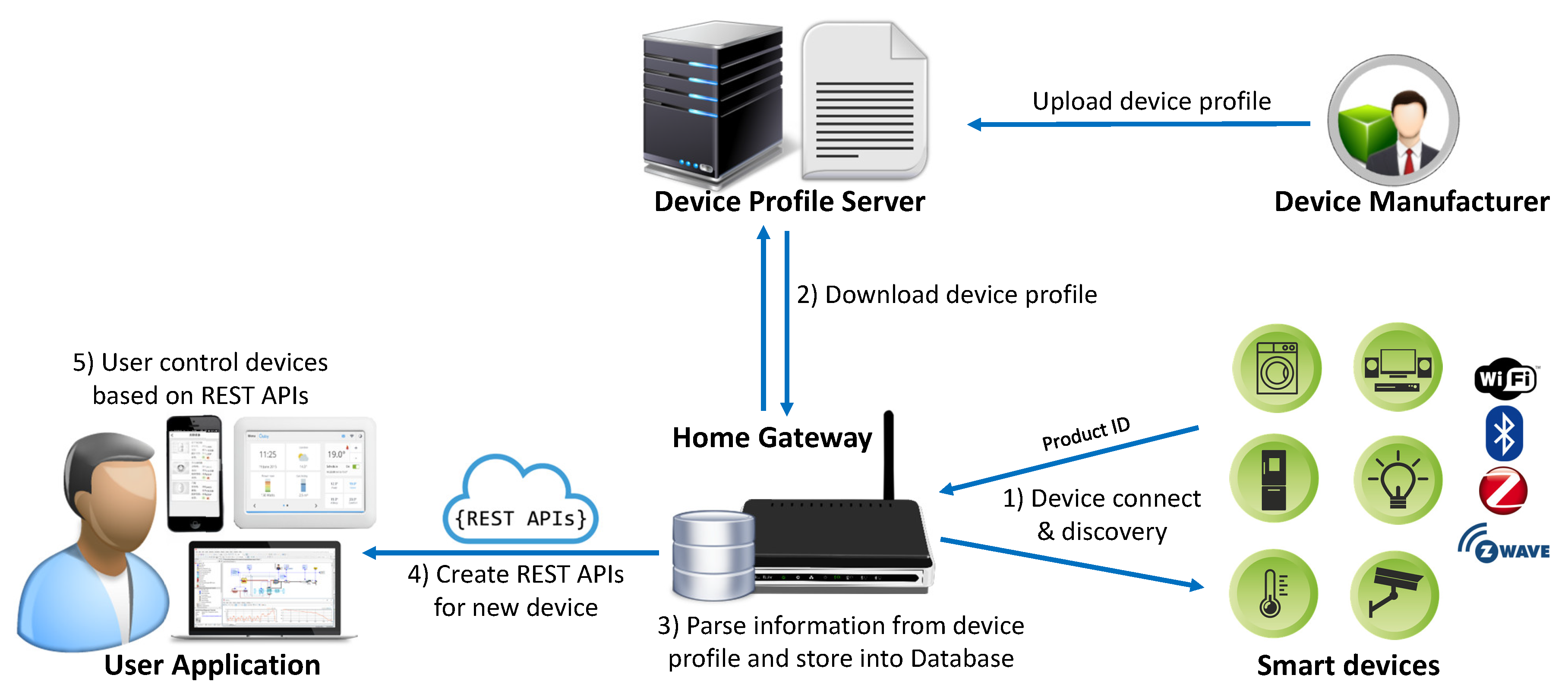
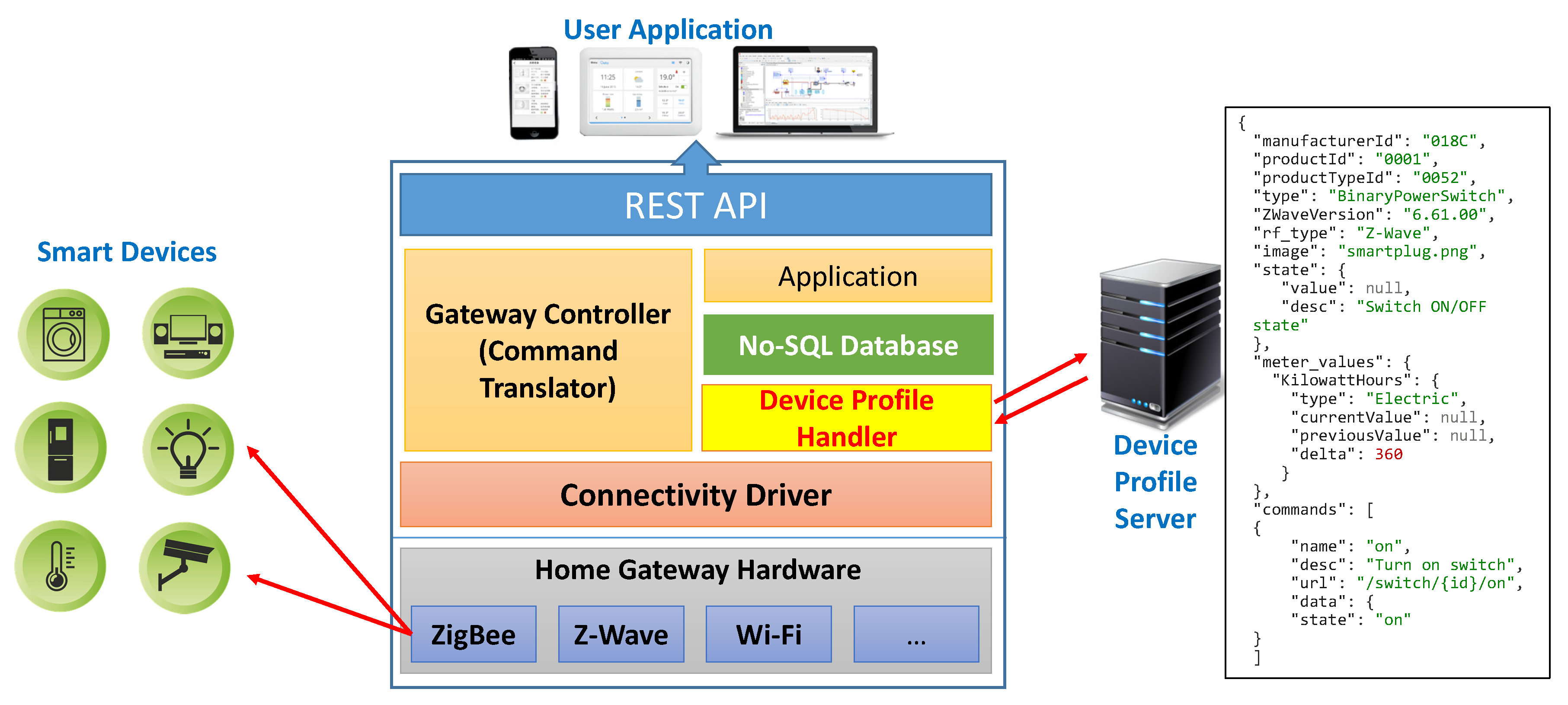

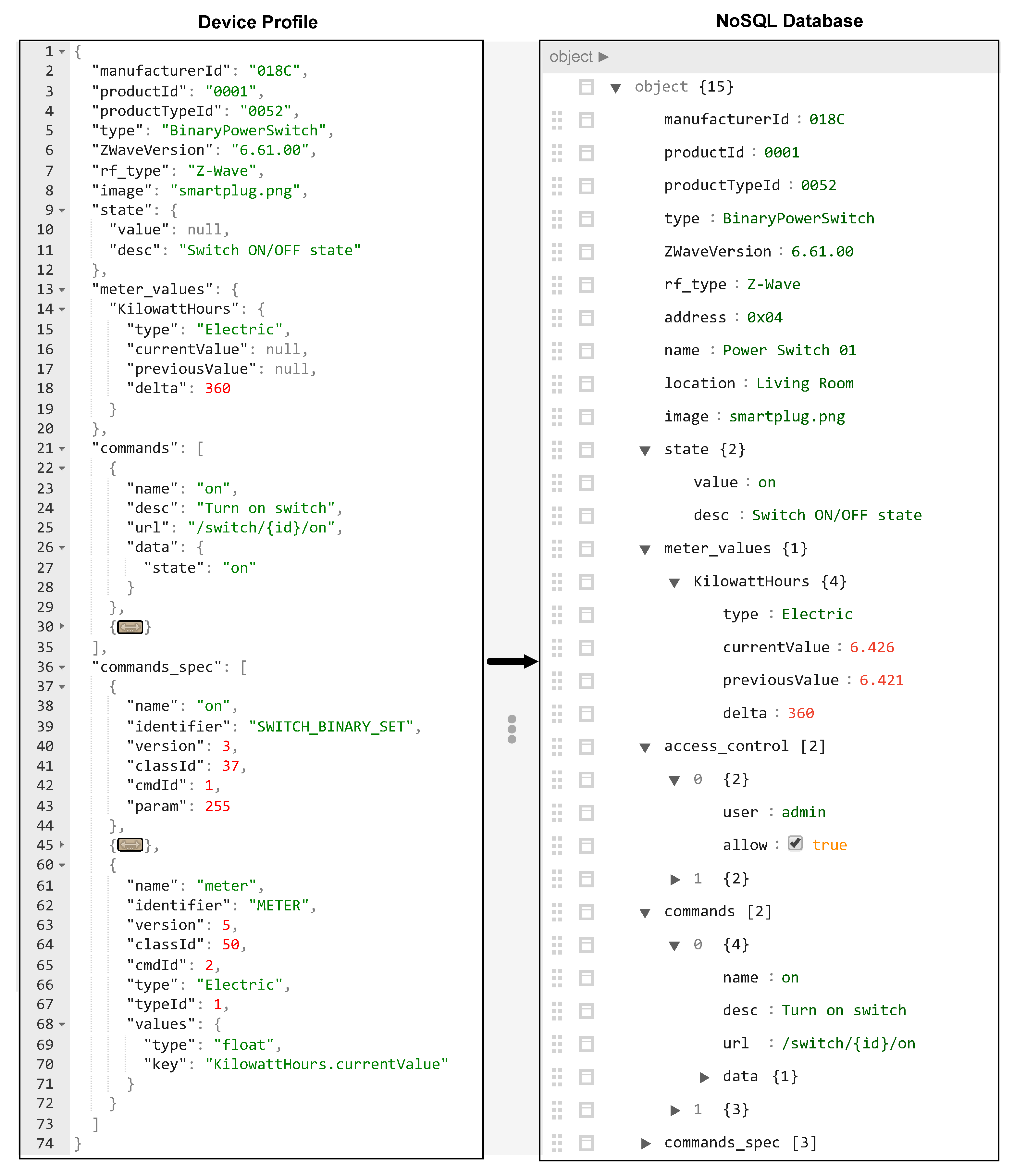
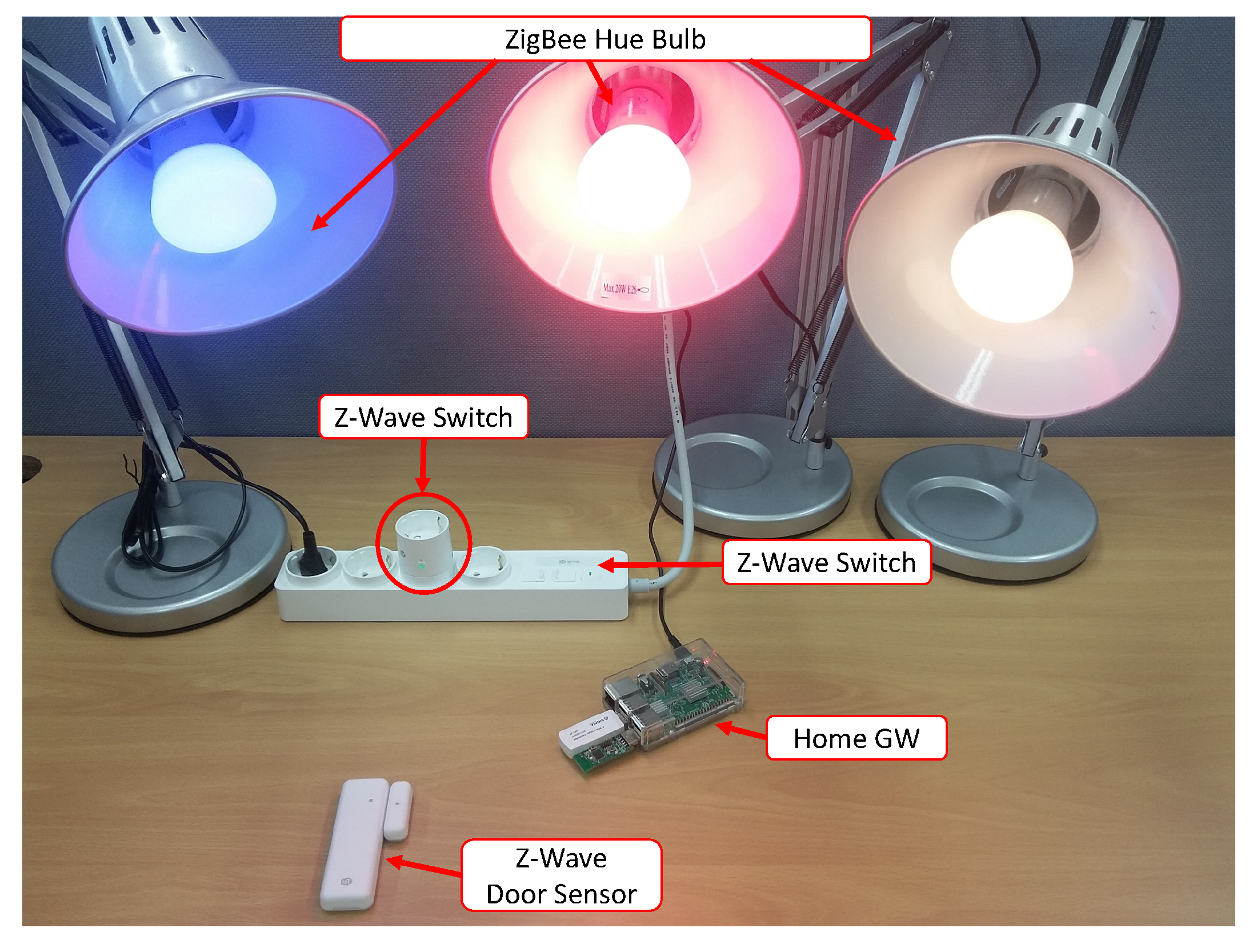
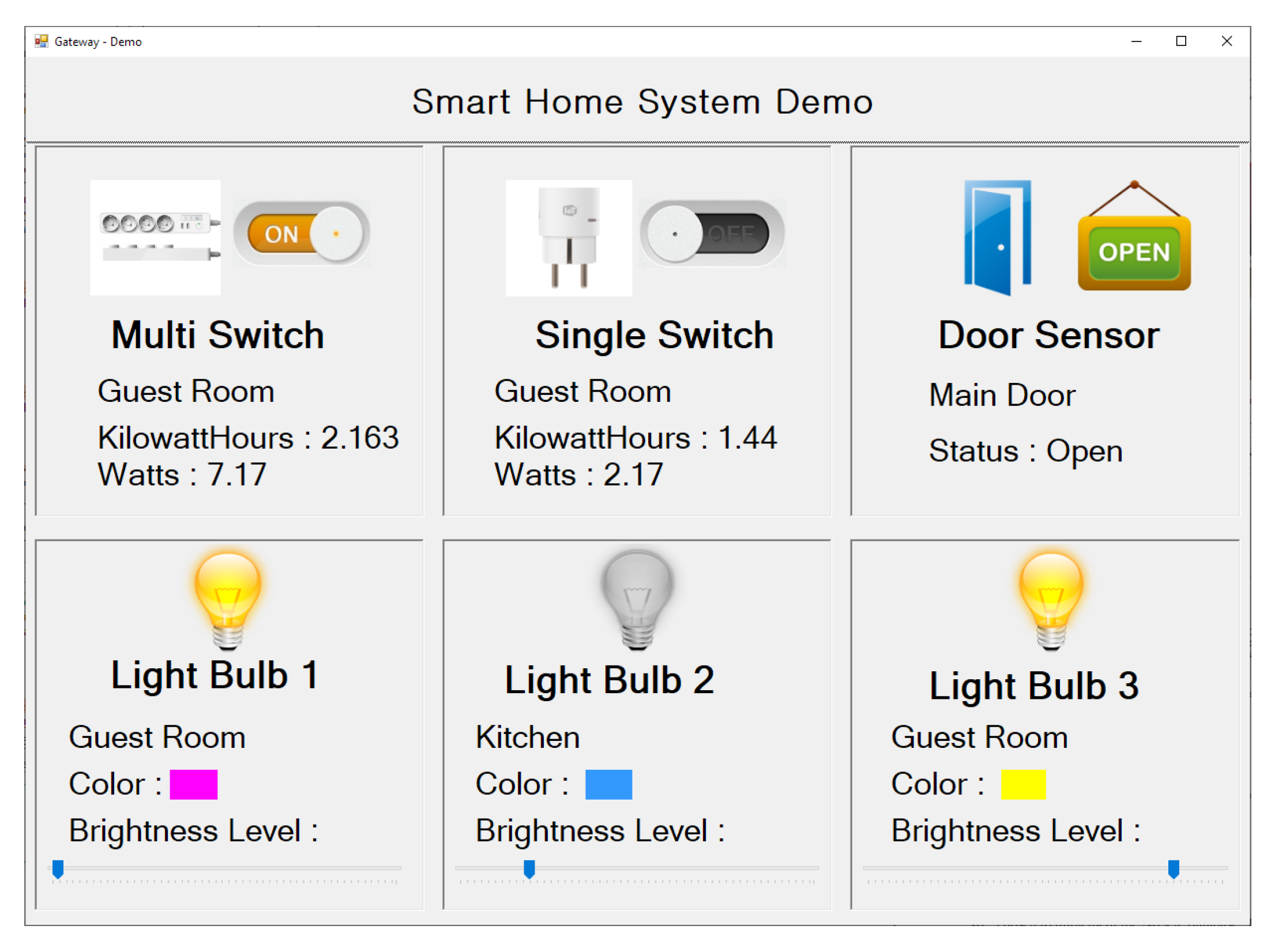
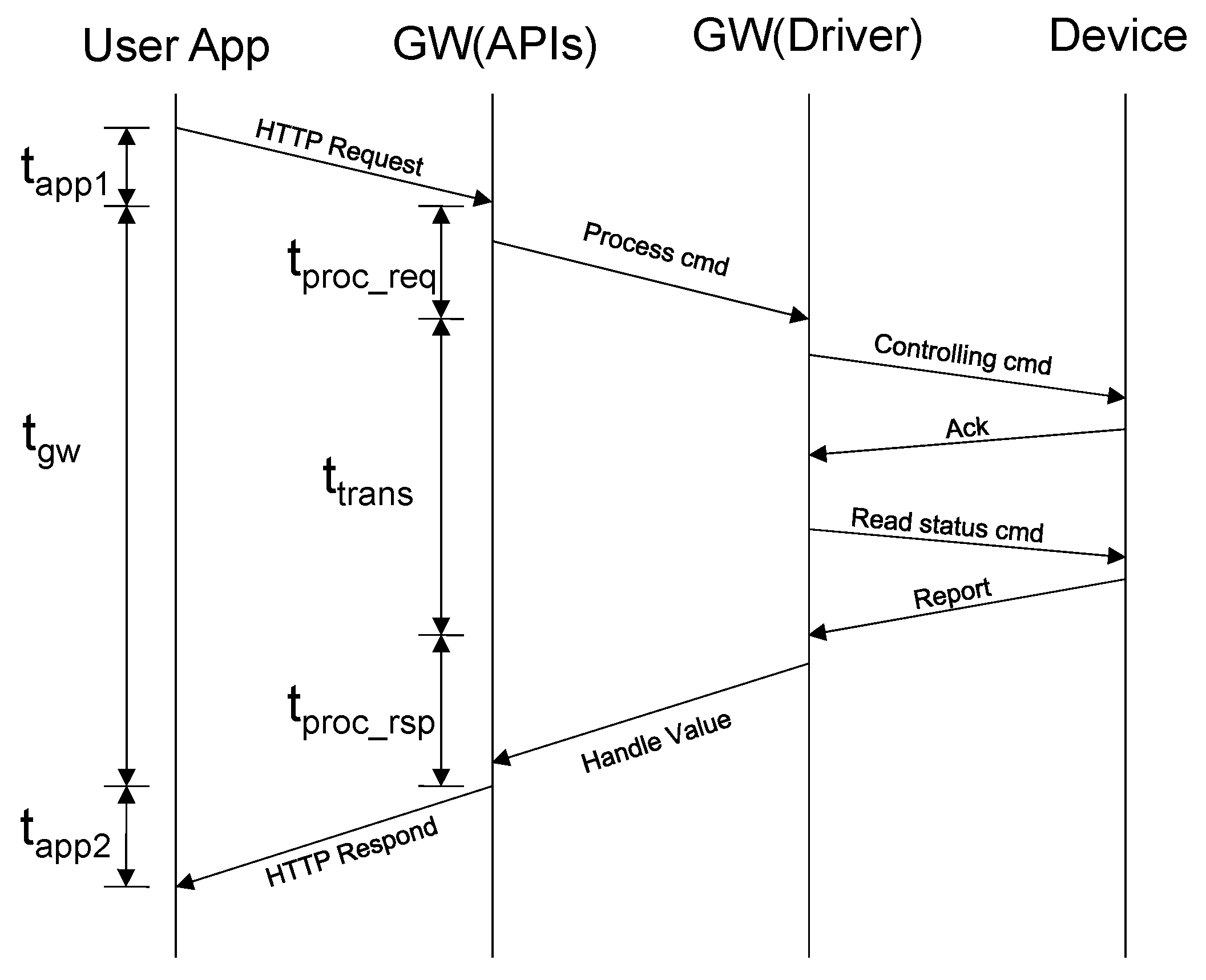
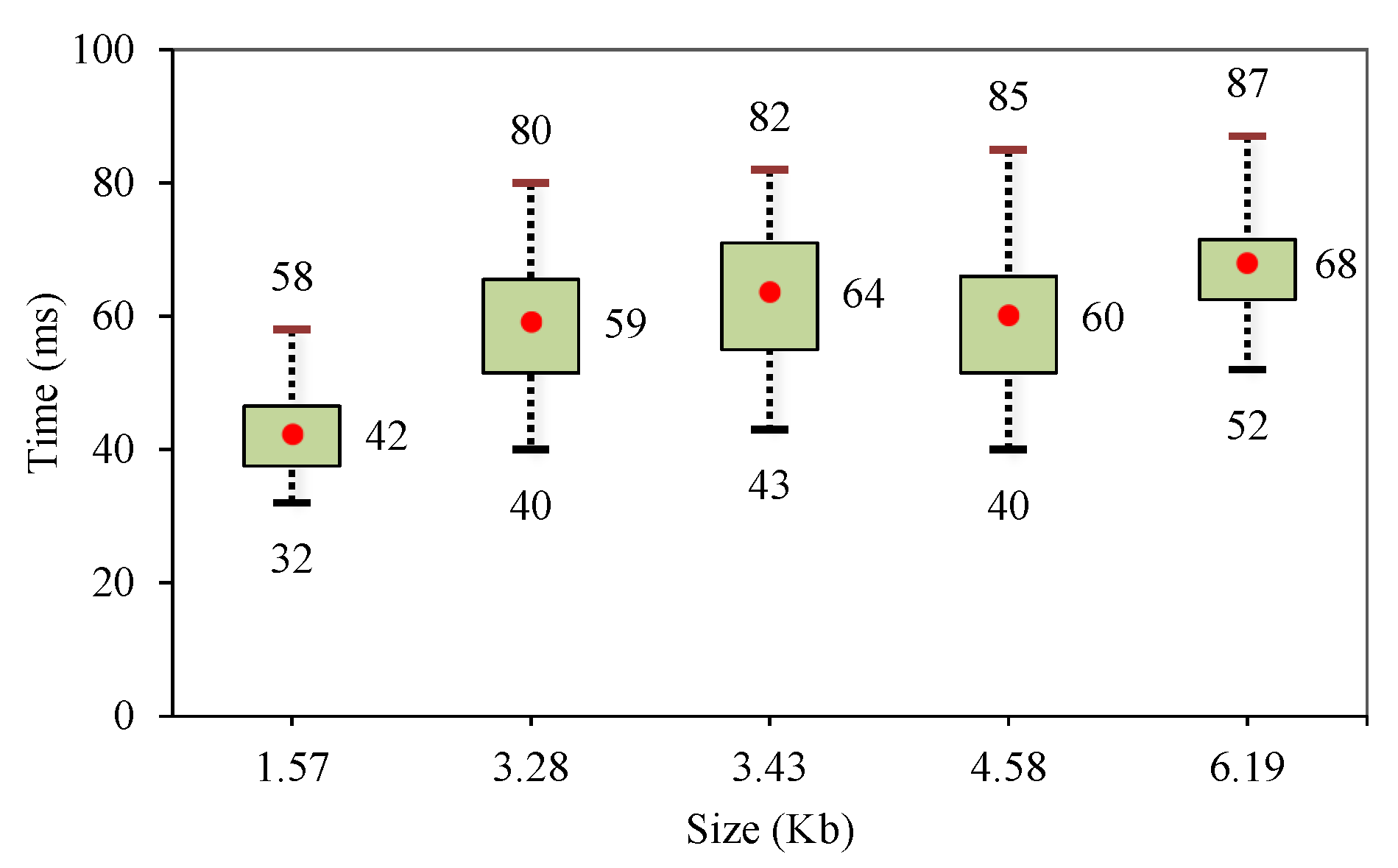
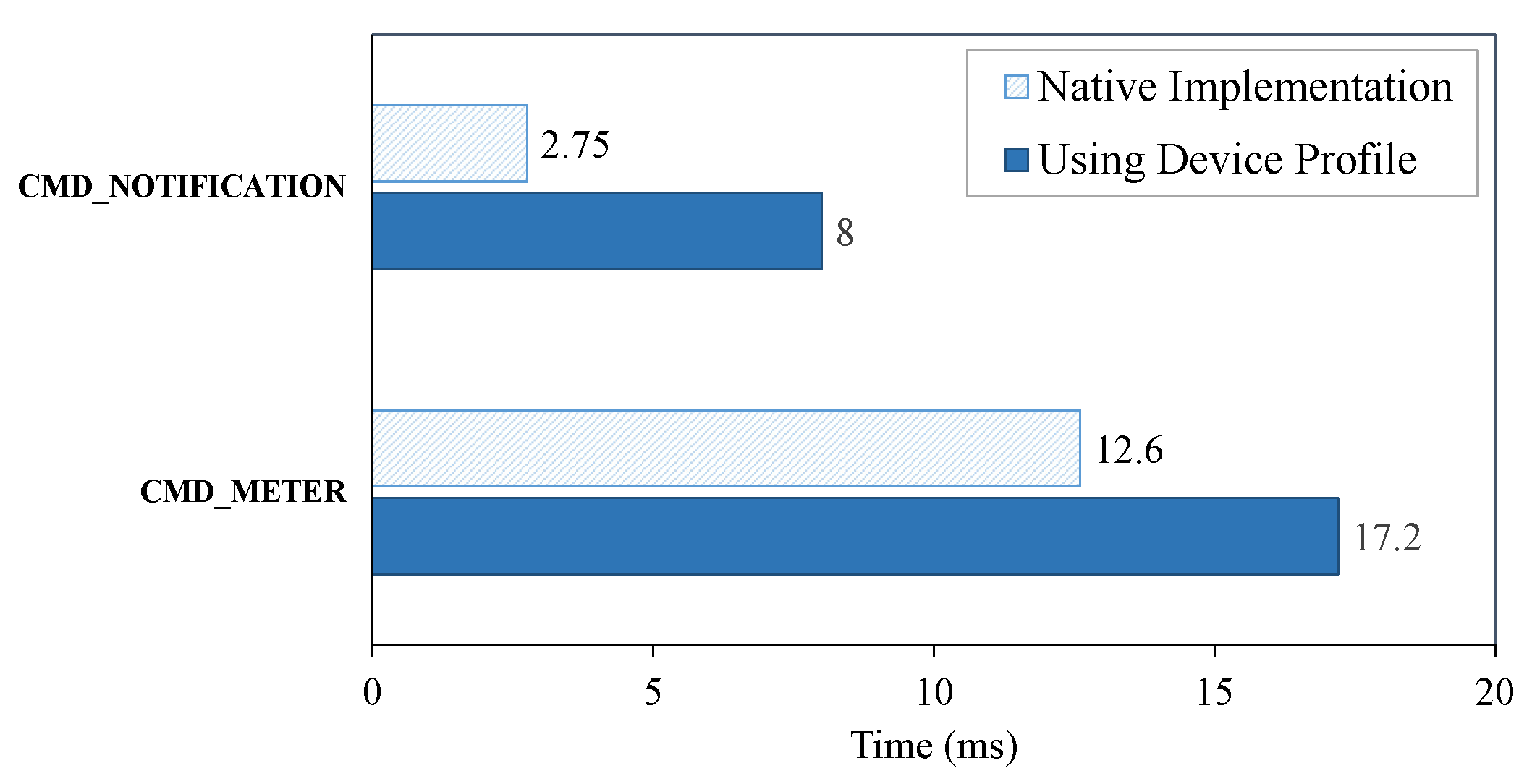
| Vendor | Supported Protocols | Supported Devices |
|---|---|---|
| Samsung SmartThings [6] | ZigBee, Z-Wave, Wi-Fi | 300+ |
| Apple Homekit [7] | Bluetooth LE (BLE), Wi-Fi | 130+ |
| Wink Hub [8] | ZigBee, Z-Wave, BLE, Wi-Fi, Kidde, Lutron Clear | 120+ |
| VeraSecure [9] | ZigBee, Z-Wave, BLE, Wi-Fi, VeraLink | 210+ |
| Homey [10] | ZigBee, Z-Wave, 433 MHz, Wi-Fi, Bluetooth | 70 |
| HomeSeer [11] | Z-Wave, Wi-Fi, Serial, Ethernet | 160+ |
| Gateway | Hardware Design | Hetero-Geneous Network | Unified Control with API | Targeted Problem |
|---|---|---|---|---|
| Kim et al. [12] | Independent gateway | Yes | Yes | Integration of heterogeneous, semantic interoperability |
| Sleman et al. [15] | Independent gateway | Yes | No | Hardware design of multi-interface gateway |
| Aloi et al. [19] | Smartphone based | Yes (Limited) | No | Mobile gateway solution |
| Moazzami et al. [20] | Smartphone based | No | No | Smartphone based home automation systems (focus on RESTful and SOAP-based smart devices) |
| Phan et al. [29] | Independent gateway | No | Yes | Z-Wave smart home gateway |
| Nugur et al. [21] | Independent gateway | Yes | Yes | IoT gateway for a cloud-based energy management system |
| Gavrila et al. [17] | TV Setup box based | Yes | No | An integration of smart home system to a TV set-top box |
| Proposed | Independent gateway | Yes | Yes | To tackle the compatibility problem between smart home devices and the gateway and support unified control over heterogeneous network |
| API Path | Example | Method | Description |
|---|---|---|---|
| /api/device | /api/device | GET | Get all devices in system |
| /api/device/{:id} | /api/device/1 | GET | Get information of device with id = 1 |
| /api/device/light/:id/{:command} | /api/device/light/1/on | POST | Turn on device (light) with id = 1 |
| /api/device/light/:id/{:command} | /api/device/light/1/color | POST | Set color for device (light) with id = 1 |
| /api/device/security/:id/{:command} | /api/device/lock/3/unlock | POST | Unlock device (lock) with id = 3 |
| Command | T | T | T | Total (T) |
|---|---|---|---|---|
| Z-Wave ON | 80 | 151 | 10 | 251 |
| Z-Wave OFF | 80 | 151 | 10 | 250 |
| ZigBee ON | 12 | 209 | 11 | 232 |
| ZigBee SET COLOR | 14 | 233 | 12 | 259 |
© 2020 by the authors. Licensee MDPI, Basel, Switzerland. This article is an open access article distributed under the terms and conditions of the Creative Commons Attribution (CC BY) license (http://creativecommons.org/licenses/by/4.0/).
Share and Cite
Phan, L.-A.; Kim, T. Breaking Down the Compatibility Problem in Smart Homes: A Dynamically Updatable Gateway Platform. Sensors 2020, 20, 2783. https://doi.org/10.3390/s20102783
Phan L-A, Kim T. Breaking Down the Compatibility Problem in Smart Homes: A Dynamically Updatable Gateway Platform. Sensors. 2020; 20(10):2783. https://doi.org/10.3390/s20102783
Chicago/Turabian StylePhan, Linh-An, and Taehong Kim. 2020. "Breaking Down the Compatibility Problem in Smart Homes: A Dynamically Updatable Gateway Platform" Sensors 20, no. 10: 2783. https://doi.org/10.3390/s20102783
APA StylePhan, L.-A., & Kim, T. (2020). Breaking Down the Compatibility Problem in Smart Homes: A Dynamically Updatable Gateway Platform. Sensors, 20(10), 2783. https://doi.org/10.3390/s20102783





